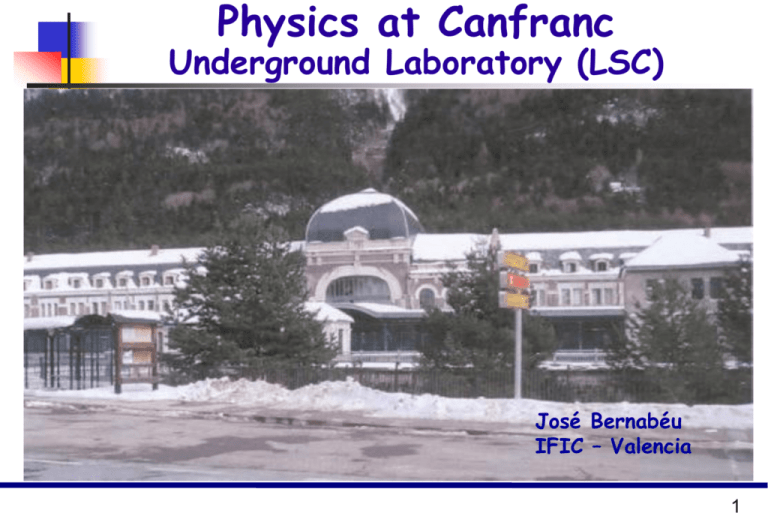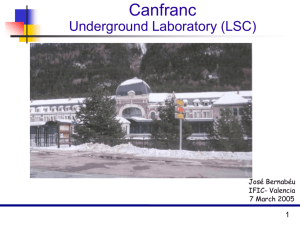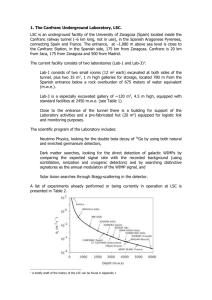Underground Physics
advertisement

Physics at Canfranc Underground Laboratory (LSC) José Bernabéu IFIC – Valencia 1 • Underground Physics • Need of Underground Space • The New LSC was inaugurated • • • • • - How to reach it ? Main Hall Ultralow Background Lab. Services and Offices Complementary Facilities Management of LSC Consortium MEC-DGA-UZ Expressions of Interest Conclusions 2 Underground Physics Physics in Underground Labs. developed during last 20 years with discoveries of great scientific impact. Why underground? This allows the screening of cosmic rays coming from space (one muon per cm2 per minute in the earth surface). Only under big rock thickness one may study certain fundamental processes. The detectors are made with the extreme radio purity materials and isolated from the radioactive environment. NEUTRINO PHYSICS - Neutrino Nature: Dirac or Majorana? 0 decay mediated by Majorana 2 neutrino mass <m> = Σ Uek mk , sensitive to CP Violating Majorana k phases. - To reach the level of 10-2 eV or less, one needs target masses near one ton and drastic background reduction Worldwide International Collaborations. 3 Underground Physics 0 would be a signal of L=2 interactions at high energy scales. Experimentally, AZ A(Z+2) + e + e gives a peak in the sum of electron energies. The solar neutrino problem was solved by SNO by comparing neutral current (total flux) and charged current (e flux) detections by deuterium. SNO is sensitive to 8B neutrinos and Borexino will be more sensitive to 7Be neutrinos in the energy region where the MSW effect in the Sun is most important. To complete the picture, a direct detection experiment is recommended for low energy pp neutrinos with few percent precision: - Definitive proof of the MSW mechanism - Measurement of Sun luminosity from neutrinos One needs a few kiloton detector. 4 Experiments 1998 - 2006 5 6 Results from MINOS • From Fermilab to Sudan, disappearance: L/E dependence Energy resolution in the detector allows a better sensitivity in Δm223 : compatible with previous results with some tendency to higher values 7 8 OPERA 9 OPERA Runs 2006 10 OPERA Schedule 2007 11 Only three? 12 LSND “Inclusion” Plot 13 MiniBoone First Results 14 MiniBoone Exclusion Plot 15 What is known, what is unknown Neutrino flavour oscillations m 23 2.4 10 eV 2 5 2 m 8 10 eV 12 o 10 13 2 3 2 sin 2 2 23 1.00 sin 2 2 12 0.81 ? Absolute neutrino masses ? 3 H beta, Cosmology Form of the mass spectrum Matter effect in neutrino propagation Majorana neutrinos ? 0: masses and phases 16 Interest of energy dependence in suppressed neutrino oscillations – CP Violation • • |Ue3| gives the strength of Appearance probability: m L 2 P ( e ) s23 sin 2 213 sin 2 ( ) 4 E 2 13 Atmospheric 2 m12 L c sin 212 sin ( ) 4 E 2 23 2 2 Solar 2 2 2 m13 L m12 m13 L L ~ J cos( ) sin( ) E 4E E 4 4 Interferen ce P(νe→νμ) • δ gives the interference pattern: CP odd term is odd in E/L • This result is a consequence of a theorem under the assumptions of CPT invariance and absence of absorptive parts • Detection by charged-current event with a muon in the final state: 440 Kton fiducial mass water Cherenkov detector This suggests the idea of a monochromatic neutrino beam to separate δ and |Ue3| by energy dependence! δ acts as a phase shift, Boosted e-Capture: To Canfranc? 17 Underground Physics DARK MATTER - Recent cosmological observations say that 95% of the matter-energy content of the Universe is unknown to us. Baryonic matter accounts for 5% (1% is visible as stars, clouds and other objects) - 70% is dark energy (we don’t know what we are talking about) - 25% is non-baryonic dark matter and most of it has to be cold: these can be particles like WIMPs with a very weak interaction with matter, of the order of one particle per day and per kilogram of the detector. - The signal is induced by coherent nuclear recoil which manifests either by light or charge or heat. - For liquid argon detector, the signal could be scintillation light produced from excited molecular states, being effective down to the keV recoil energy one ton detector would provide much better sensitivity. 18 Need of Underground Space At present, there is an increasing interest in the Underground Physics described before with a series of proposals, letters of intent or conceptual designs at different levels of development. The present restrictions in the available underground space and the corresponding infrastructures are the most important limitations to the development of the field, including the creativity of the community of physicists. Furthermore, the existing advances were made possible due to a certain redundancy in some of these delicate experiments, using experimental techniques either complementary or different: think of the examples of solar neutrinos. The good environmental conditions of Canfranc Lab. justified the project for the new facility which is now inaugurated: it contains two experimental halls. 19 Need of Underground Space Existing facilities in the EU, grouped in the ILIAS Network: - LNGS: INFN Lab. with site in Gran Sasso Tunnel under the Apeninos - LSC: Conceived by Angel Morales in 1985 under the Spanish Pyrenees The past underground facilities were inside the (unused) railway tunnel and had LAB-1 and LAB-3 as working laboratories. In LAB3 the muon flux is 2x10-3 m-2 s-1, that of neutrons is (3,8 ± 0,4) x 10-2 m-2 s-1 and that of gammas is 200 m-2 s-1. Radon activity is variable around 50-100 Bq m-3. The scientific program included dark matter search (ANAIS, IGEX-DM, ROSEBUD) and 0 (IGEX-2) - LSM: French Lab. belonging to IN2P3 (CNRS) and DSM (CEA), with site in the Frejus Tunnel in the Highway connecting Lyon with Torino. - Boulby Mine Underground Facility, near Sheffield: dark matter collaboration in UK 20 The new LSC The Main Hall has 40 x 15 x 12 m3 and it is oriented towards CERN A smaller Hall of 150 m2 of surface and 8 m height constitutes the ultralow background Lab. for dark matter studies and other needs. In the access corridor, one has a White Hall, offices and workshops for more than 1000 m2. 21 Complementary Facilities Besides the laboratory, the work already made included the basic infrastructure of ventilation, electric power and safety. All these works inside the Lab. were finished in November 2005. As seen in the plan, the access to the facilities is extraordinarily easy. The geologic conditions, the absence of underground water, etc., are positive too and make LSC a very good candidate for future terrestrial neutrino experiments with further excavations. The new LSC has to have service structures in the surface: general ones like electric, hydraulic, ventilation, experimental setup, safety, administration, etc., as well as those directly related to experiments as computing, networks, mechanical workshops, storage, offices, residences, etc. 22 Complementary Facilities A definite Project is being settled by the authorities of the Consortium MEC-DGA-UZ to have appropriate installations outside the Lab. As external facilities, one contemplates the store and workshops, mechanical as well as electronic, the deposits for cryogenic liquids and two buildings for general services. This will be the main external reference and the official site of the Lab. • The two buildings will be the one to the left restored and a new one to be built nearby. 23 Management of LSC The new LSC has a structure adapted to the legal environment of Spain. The administrative structure is that of the Consortium. The management of LSC contemplates: 1. The Government bodies of the Consortium 2. The Scientific Advisory Committee 3. The Director General and two Associate Directors for specific responsibilities. The LSC will have its own budget and staff depending of the Directorate. The members of the Lab. with equal duties and rights in agreement with their qualification, will be not only the proper staff of the Lab., but also the attached personnel from the University of Zaragoza or other Institutions, as well as attached fellows. The present group of Zaragoza is associated to the new Laboratory. 24 Scientific Policy Committee The MEC followed a methodology, to start with the management of the LSC, of appointing a SPC for 2005 and 2006 with the following tasks: - To define the International Character of the Lab. and the corresponding Programming as such from the very beginning. - To promote International Collaborations with experiments to be installed in this Facility. - To propose to the Consortium Bodies the Directorate of the Lab., with the control of the quality of the installations in the overall Facility. UNDERGROUND LABORATORY OF CANFRANC SCIENTIFIC POLICY COMMITTEE •Chairman: Prof. Jose Bernabeu (IFIC, Spain) •Secretary: Prof. Domenec Espriu (PP Programme) •Members: Prof. Frank Avignone (South Carolina, US) Prof. Eugenio Coccia (Director of LNGS, Italy) Prof. Enrique Fernandez (IFAE, UAB, Spain) Prof. Concepcion Gonzalez-Garcia (SB, US) Prof. Rafael Rebolo (IAC, Spain) Prof. Michel Spiro (Director of IN2P3, France) Prof. David Wark (Rutherford Lab., UK) 25 The LSC starts officially On Monday 27 March 2006, the LSC was inaugurated by - The Minister of Education and Science - The President of the Aragon Government - The Rector of the University of Zaragoza and they proceeded to the signature of the agreement for LSC. http://www.unizar.es/lsc The SPC, in its meeting of 10 March 2006, recommended to the Consortium parties the appointment of the Directorate Team formed by: - Professor Sandro Bettini, as Director General - Professor Julio Morales, as Associate Director - Professor Jose Angel Villar, as Associate Director This Team was selected among the candidates that had applied in an International Call announced since November 2005. The SPC, in several meetings, decided to proceed with the Expressions of Interest that were presented by International Collaborations in the framework of an International Call announced since July 2005. The experiments were defended orally in an OPEN SESSION on July 6th 2006 in Canfranc. The SPC finished its work on October 2006 with the first meeting of Consejo Rector. Professor Alessandro Bettini is the DG of the Lab. Since the begining of 2007. - Dark Matter Searches - Double Beta Decay - Gravitation 26 Galactic Dark Matter Observe galaxy rotation curve using Doppler shifts in 21 cm line from hyperfine splitting 27 Detection of Dark Matter Direct detection CDMS-II, Edelweiss, DAMA, GENIUS, etc Indirect detection SuperK, AMANDA, ICECUBE, Antares, etc complementary techniques are getting into the interesting region of parameter space 28 Particle Dark Matter Stable, TeV-scale particle, electrically neutral, only weakly interacting No such candidate in the Standard Model Lightest Supersymmetric Particle (LSP): CDMS-II superpartner of a gauge boson in most models LSP a perfect candidate for WIMP - But there are many other Detect Dark Matter to see it is there. possibilities (techni-baryons, Produce Dark Matter in accelerator gravitino, axino, invisible axion, experiments to see what it is. WIMPZILLAS, etc) 29 ZEPLIN III: two phase liquid xenon detectors with high background rejection capability Electron recoils (background): primary scintillation + strong secondary scintillation Nuclear recoils: primary scintillation + weak secondary scintillation 30 ZEPLIN III: 2-Phase Xenon WIMP Detector Discrimination between electron and nuclear recoils using scintillation and ionisation in liquid Xenon vacuum vessel LXe vessel (-100 C) All copper construction E field region 35 mm liquid + 5 mm gas 31 PMTs in LXe 31 ZEPLIN III: Technical drawing LXe chamber Fiducial volume of LXe m 15 kg 31 PMTs (2-inch) Vacuum jacket Liquid nitrogen tank (enough to run about 42 hours without refill) All metallic parts – OFHC Copper 32 ZEPLIN III: will it work all together ? 33 ZEPLIN III: it is real ! 34 35 The ArDM Project C. Amsler, V. Boccone, A. Buechler-Germann, C. Regenfus Zurich University, Switzerland A. Badertscher, A. Baeztner, R. Chandrasekharan, L. Kaufmann, L.Knecht, M. Laffranchi, A. Marchionni, G. Natterer, P. Otiougova, A. Rubbia*, J. Ulbricht ETH Zurich, Switzerland A. Bueno, M.C. Carmona-Benítez, J. Lozano, A.J. Melgarejo, S. Navas University of Granada, Spain H. Chagani, E. Daw, V. Kudryavtsev, P. Lightfoot, P. Majewski, N. Spooner University of Sheffield, U.K. M. Daniel, P. Ladrón de Guevara, L. Romero CIEMAT, Spain P. Mijakowski, P. Przewlocki, E. Rondio Soltan Institute Warszawa, Poland We acknowledge informal contribution from LNF, Italy. Interest from JINR, Russia. 36 One ton prototype best R&D towards future large DM detectors is to build and operate a realistically-sized prototype under realistic conditions. E-field GAr LAr WIMP Charge extraction from liquid argon to gaseous argon, amplification and readout with Large Electron Multiplier (LEM) Reflecting + WLS VUV mirror Field shaping + immersed HV multiplier Light readout (scintillation light at 128 nm) Drift length 120 cm Target mass: ≈ 1000 kg Drift field: 1 to 5 kV/cm 37 ANAIS Instituciones Universidad de Zaragoza (UZ) Localización Laboratorio subterráneo de Canfranc Descripción ANAIS es un experimento destinado a la búsqueda de efectos de modulación anual en la señal de WIMPs con 10 centelleadores de NaI (107 kg). Con el fin de mejorar los dos factores que determinan la sensibilidad de este tipo de experimentos (el umbral de energías y el fondo radioactivo en sus proximidades) se ha puesto en marcha en el Laboratorio Subterráneo de Canfranc un prototipo con un único detector sobre el que se están realizando diversas modificaciones: se ha instalado una nueva base externa de teflón en el fotomultiplicador, se va a sustituir éste por otros de ultrabajo fondo radioactivo situados fuera del blindaje interno, etc. Al igual que para el experimento completo, el detector se ha instalado en un blindaje que consiste (de dentro a fuera) en 30 cm de plomo de baja actividad, 2 mm de cadmio y 40 cm de polietileno y agua borada. Además, una bolsa de PVC mantenida a sobrepresión por la inyección de N2 gas evita la entrada de radón y se han dispuesto vetos anti-muones cubriendo la parte superior del dispositivo. La adquisición mediante un osciloscopio digital de los pulsos de los sucesos ha permitido discriminar el ruido a través del análisis de la forma de los mismos, reduciendo el umbral de energía del detector hasta 4 keV. También va a implementarse un sistema de control para garantizar la necesaria estabilidad de las condiciones ambientales: temperaturas, niveles de radón, ganancia, ... 38 ANAIS Detalle del experimento prototipo con un único cristal de 10.7 kg Depósitos de agua borada cerrando el blindaje del prototipo Láminas de cadmio y polietileno en el blindaje del prototipo Blindaje de plomo (30 cm) del experimento prototipo con un único cristal de 10.7 kg 39 Double beta decay 2- Large number of even-even nuclei undergo double-beta decay, but not single-beta decay Standard Model process of 2 is also allowed of course Enrichment procedure in place for about 10 isotopes You do not search for peaks in unknown places: you always know where to look Q value of the decay is well known (difference in energy between two isotopes) 76 As 0+ 76 Ge 0+ 2+ 0+ 76 Se e e p n n p e n p 2 n e p 0 40 Double beta decay 76Ge Two Neutrino Spectrum Zero Neutrino Spectrum 1% resolution (2 ) = 100 * (0 ) example 0.0 0.5 1.0 1.5 Sum Energy for the Two Electrons (MeV) 2.0 Q Endpoint Energy 41 Present Cuoricino/NEMO-III region Possible evidence (best value 0.39 eV) “quasi” degeneracy m1 m2 m3 Inverse hierarchy m212= m2atm Direct hierarchy m212= m2sol Cosmological disfavoured Region (WMAP) 42 Super-NEMO and Bi-Po Based on NEMO-III technology, SM only background Study Se, Nd, Mo, low SM background Design study started 2005 Feasible if: a) BG only from 2n bb (NEMO3) b) DE/E = 10% at 1 MeV (8% has already been demonstrated in recent R&D) 43 Bi-Po in Canfranc • NEMO III is installed in Frejus. The Bi-Po detector (bigger than NEMO III) for SuperNEMO is going to be installed in the new LSC. • The International Collaboration contains at present two groups from Valencia, one group from Barcelona and one group from Zaragoza. • Coordinator of the Spanish participation is J. J. Gómez Cadenas. • This tracking detector is complementary to the bolometric GERDA and CUORE, with its capability to measure the single electron energy (in both 2 and 0 channels) and the angular correlation between both electrons. SuperNEMO will use different isotopes. 44 Gravity Tests -Torsion Pendulum -Test of the Equivalence Principle mi = mg - Precision in the measurement of Newton Constant - Deviations from the Inverse Square Law at small distances 45 Spin-dependent DM interaction 46 Spin-dependent DM interaction • SIMPLE experiment consists of superheated droplet detectors. • Aim: improvement of restrictions on the allowed phase space of spindependent coupling strengths of Dark Matter Particles with target nuclei. WIMP proton exclusion plot 47 Low Temperature Instrumentation 48 Outlook Good luck to the new LSC! Unique in Spain. Crucial for Underground Space in Europe. Experiments of unprecedented interest and dimensions for the International Scientific Community. New Spanish groups are encouraged to participate in the experiments to be installed in the LSC. 49 Rendez-vous See you in ‘El Tobazo’ 50






